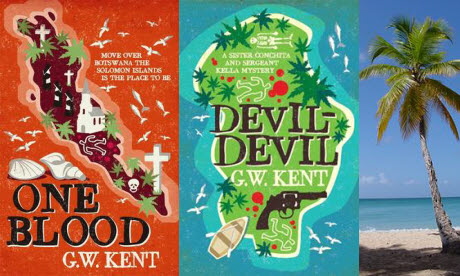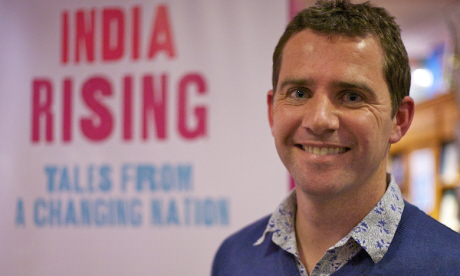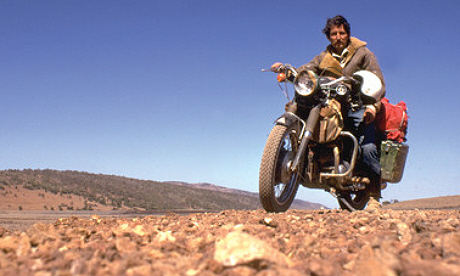
Author G W Kent reveals all about his riveting Solomon Island-based murder mysteries
It is fashionable of late to set crime novels in some bleak Scandinavian country and make the crimes as grisly and gratuitous as possible. G W Kent, however, sets his tales in the impossibly colourful Solomon Islands. And the crimes are altogether more interesting, tied up with local customs, beliefs and rivalries.
I first came upon G W Kent's murder mysteries last Christmas, when his book, Devil-Devil, was part of an Amazon Kindle promotion. The greatest compliment I can give both Devil Devil, and its sequel, One Blood, is that I wanted to book a seat on the next flight to Honiara after reading them.
I spoke to G W Kent about the novels, his deep knowledge and love of the Solomons and why we should all go out of our way to visit them. Soon.
Why did you choose to set your novels in the Solomon Islands?
Forty years ago, when I first arrived in the Solomon Islands they were among the most fascinating, beautiful and dangerous areas in the world. They are still worth a visit, or better still an extended stay.
A string of hundreds of thickly forested, mountainous islands, surrounded by beautiful reefs and a deep blue sea, they extend for almost 1,000 miles across the South Pacific. About 160,000 islanders spoke between them 80 different languages and communicated with one another in the linqua franca of Pidgin. They lived in thatched bamboo huts and their lives were self-sufficient. The women grew subsistence crops in gardens on the sides of hills, while the men fished in dugout canoes many kilometres out at sea and hunted wild pigs among the trees of the ‘bush’.
Many of them lived as their ancestors had done for centuries, in tiny, remote villages, governed by age-old traditions and customs and observing the laws of what was tabu, forbidden by the gods. In some areas the older people still worshiped sharks, porpoises, crocodiles and eagles, depending upon which clan to which they belonged. They believed that the spirits of their gods, or ‘ghosts’ lived in rivers, lakes, bushes and rocks.
Starting in the 1960s, I was lucky enough to spend much of my time in the remoter parts of these islands, travelling on foot and by canoe through jungles and across rivers reefs and mountains.
You ran an educational broadcasting service in the Solomon Islands for eight years. Tell us about that.
My job was to help with the education of young village children by writing, recording and broadcasting basic schools radio programmes and then travelling on my own among the islands, at night being housed and fed on taro, sweet potatoes and coconuts by the villagers, recording new programmes and helping the untrained local teachers to use the broadcasts.
In this way I met thousands of islanders in their homes. From time to time, I also met a handful of intriguing expatriates who had made their homes in out-of-the-way places. They were a polyglot lot – traders, gold prospectors, small ship skippers, soldiers of fortune and missionaries. The latter were particularly impressive, especially the white-robed Marist Catholic sisters of all nations – American, British, French, Dutch, Irish and German. They lived in small, isolated communities in the jungles and on the sides of mountains, scarcely receiving visitors from the outside world, living in conditions of considerable hardship and devoting their lives to teaching, healing and the service of God.
Just as impressive were the indigenous policemen I met on my travels. There were not many of them – about 300 to cover 1,000s of square miles of mountainous jungles, raging seas and crocodile-infested rivers and lakes. They investigated, usually single-handedly, inter-tribal feuds, witch-doctor murders, territorial disputes sometimes going back for centuries, and a variety of ‘custom’ crimes. Doggedly they would travel on foot for 100s of miles in pursuit of culprits, often defying the all-powerful district headmen and ramos, or hired killers.
As the years passed and I grew to know the islands a little better, I began to wonder what might happen if one of these tough pagan police officers should be forced to link up with a young American nun, two people from completely different cultures forced to combine to track a malevolent killer. Decades later this proved to be the inspiration for my Sergeant Kella and Sister Conchita series.
The books are rich in detail about the Solomon Islands, its people and its cultures. Was that researched? Or based on your experiences on the islands?
It would have been impossible for anyone to spend so much time among so many different indigenous people without becoming enthralled by their general cultural background. The islanders were – and are – divided into two main groups, the bush people, who live high in the mountains, and the salt water men and women, who live in villages along the coastal strips of the islands. The two groups were bitter enemies and would often fight. A common battleground would be a strip of neutral territory in each area where bushmen and salt water men would reluctantly meet to exchange fish for pigs. Often the bartering would lead to quarrels and then fights. Sometimes there would be bloodshed and even deaths, although these were seldom reported to the colonial authorities behind their desks in the small capital of Honiara on Guadalcanal island.
An interesting offshoot of the rivalry between bush and coastal dwellers was the construction of artificial islands in several lagoons off the island of Malaita. For over a century, salt water people, tired of raids from bush war-parties, and fed up with the attentions of malaria-carrying mosquitoes, moved out into the middle of these sheltered lagoons. They built whole islands out of stones carried out from the mainland on rafts. On top they constructed their homes. Today there are dozens of these man-made islands, some of the larger ones bear more than 50 huts.
Another important cultural custom was the exchange of shell money, which still prevails. Shell money consisted of bands of beautiful, specially selected seashells strung along lengths of twine. These are still essential in some areas if a young man wishes to get married. He has to negotiate the bride-price of his fiancée with his future in-laws, handing over an agreed number of strings of shells in return for permission to marry her.
After many years I tried to put together what little I had learned about the cultural background of the Solomons and wrote an M.Phil thesis which I submitted to a university. This was a long time ago, and I have no means of judging its quality, but at least I think I can claim that it must be one of the few academic studies which includes an interview with a tree-shouter, an old bushman claiming to have the inherited gift of felling trees just by shouting abuse at them!
One of my favourite aspects of the book is how the character of Ben Kella, has to balance his role as a police sergeant and aofia, traditional law-bringer of the islands. Is he a metaphor for the islands themselves, having to come to grips with modern governance in the face of traditional beliefs and customs?
A reviewer of one of my Kella and Conchita books pointed out that the theme of both novels so far published in the series is that of change, and I believe this to be true. Kella is a mission-educated islander who has been sent overseas on degree courses. His job is to uphold the white colonial law. But he is also the aofia, the traditional law-bringer of the artificial islands, charged by the old custom priests to maintain the old custom ways. This double charge often brings him into conflict with the authorities and his own people, who sometimes accuse the sergeant of being a sycophantic black whiteman.
These double standards affect many educated young islanders, trying to live in two different societies at the same time in the Solomons today. Some give up trying and go back to their island in despair, but there they discover that they are now out of place; they have experienced a much wider world and the old village ways are not enough for them.
How strong are the ‘old ways’ still in the Solomons? Did you come across any examples while you were in the islands?
Despite the efforts of real-life local politicians and officials, who like my fictional Sergeant Kella are trying to bring the Solomons into the 21st century, it will take many years for all islanders to live in harmony. Old fissures are too deep. This was displayed only a few years ago on the island of Guadalcanal, some time after independence had been granted to the territory. Many people from Malaita had settled on the island, leading to land disputes. Some of he Guadalcanal people had risen in arms against the Malaitans and driven them off the island. An official Australian force had to be called in to restore order.
The expats don’t come across too well in your books. Are those kinds of drifters looking for a fast buck still prevalent in the islands?
The expatriates in the Solomons less than half a century ago numbered less than 1,000, most of them living in the capital. Most shops were run by the Chinese community, but apart from the government officials, the majority of white people found it difficult to make a living. One sad experience I had, occurred when I was travelling back to Honiara by small boat. The vessel put in at a copra plantation and took on board the distraught white owner, a man in his 50s. For the entire trip back he sat in the prow on his own his body racked with sobs. One of the seamen told me that his plantation had been forced to close after many years, because of the world wide slump in copra prices. The owner had no money left and was being shipped back home by the authorities as one of the notorious DBSs – Distressed British Subject.
Most of the expatriates in the islands were colonial civil servants, a rapidly diminishing bunch. Most of them had joined the colonial service in its heyday, just after the war. Within a couple of decades, with the worldwide spread of independence, there were few territories left in which to employ them. Those left in the Solomons were cynically known as ‘African Retreads’ because they had started their careers on that continent. They were still clinging grimly on to their sinecures but every year more were being made redundant. Some still did their best, but many had more or less given up and were literally making the most of their last few days in the sun.
One of the most disturbing parts of the new book, One Blood, is the destruction of the natural environment by logging companies. Is that still a problem the islands face?
Realising that grants in aid from Britain would soon be coming to an end, the Solomons were desperate to attract sources of revenue. To this end they invited in commercial logging, shipping and agricultural concerns. The loggers razed a couple of islands in their efforts to export timber. Fortunately, the islands were so remote that getting the timber out proved too expensive. Most of the commercial companies gave up on their logging activities but the horrendous results of their activities in what had been an earthly paradise may still be seen in some areas in the form of ruined beaches and reefs and polluted rivers and lakes.
Of course, the other main character in the series in the feisty nun, Sister Conchita. Do the missions run by churches still have a strong influence in the islands?
Missionaries of different denominations have done and continue to do a marvelous job, in the areas of health, education and spreading the word of God. Their paths have never been easy, and in the last few decades a number have lost their lives for their faith.
What can travellers expect when they visit the Solomon Islands?
Honiara, the only real town, is on the scruffy side and should be used mainly as a jumping off place for the rest of the Solomon Islands. Outside the capital visitors will encounter warm, charming, hospitable people, beautiful vistas, a laid-back and relaxed lifestyle, a warm sea, lovely beaches, a variety of animal life and an engrossing cultural scene.
What do you miss most from your time in the Solomon Islands?
The place and the people. I spent the happiest years of my life in the Solomons and would urge anyone who gets the chance to try to visit the Happy Isles as soon as possible, while they are still largely unspoiled.
And, finally, are there any more Ben Kella/Sister Conchita mysteries in the pipeline?
I think it would break my heart to have to stop writing about the South Pacific. Another Kella and Conchita book is completed. It is called Killman and will be published next year. In it, a custom priest claims to be a reincarnation of Noah, but he is drowned outside his ark. Sergeant Kella and Sister Conchita investigate!
 One Blood, the latest installment in GW Kent's Ben Kella and Sister Conchita series, is available on Amazon now. So too is the first book in the series, Devil Devil.
One Blood, the latest installment in GW Kent's Ben Kella and Sister Conchita series, is available on Amazon now. So too is the first book in the series, Devil Devil.
For more travel secrets from the world's most famous wanderers, visit our Interviews page.
 Daniel Nettheim: Willem Defoe's search for the last Tasmanian tiger
Daniel Nettheim: Willem Defoe's search for the last Tasmanian tiger
Director Daniel Nettheim on working with Willem Defoe and the existence – or otherwise – of Tasmanian tigers More
 Oliver Balch: India on the rise
Oliver Balch: India on the rise
Journalist and author Oliver Balch talks to Peter Moore about the rise of India and what it means to travellers More
 Ted Simon: The Godfather of Motorcycle Adventure
Ted Simon: The Godfather of Motorcycle Adventure
Ted Simon talks to Peter Moore about his legendary motorcycle adventures and what he'd do differently if he was starting out today More